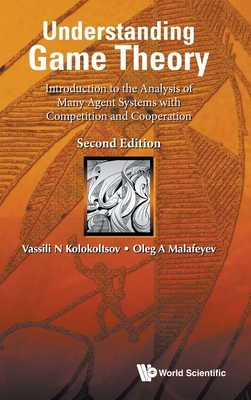Understanding Game Theory: Introduction to the Analysis of Many Agent Systems with Competition and Cooperation (Second Edition)
暫譯: 理解博弈論:多代理系統中競爭與合作的分析導論(第二版)
Kolokoltsov, Vasily N., Malafeyev, Oleg A.
- 出版商: World Scientific Pub
- 出版日期: 2020-09-07
- 售價: $5,180
- 貴賓價: 9.5 折 $4,921
- 語言: 英文
- 頁數: 412
- 裝訂: Hardcover - also called cloth, retail trade, or trade
- ISBN: 9811214859
- ISBN-13: 9789811214851
-
相關分類:
離散數學 Discrete-mathematics
海外代購書籍(需單獨結帳)
商品描述
Steadily growing applications of game theory in modern science (including psychology, biology and economics) require sources to provide rapid access in both classical tools and recent developments to readers with diverse backgrounds. This book on game theory, its applications and mathematical methods, is written with this objective in mind.The book gives a concise but wide-ranging introduction to games including older (pre-game theory) party games and more recent topics like elections and evolutionary games and is generously spiced with excursions into philosophy, history, literature and politics. A distinguished feature is the clear separation of the text into two parts: elementary and advanced, which makes the book ideal for study at various levels.Part I displays basic ideas using no more than four arithmetic operations and requiring from the reader only some inclination to logical thinking. It can be used in a university degree course without any (or minimal) prerequisite in mathematics (say, in economics, business, systems biology), as well as for self-study by school teachers, social and natural scientists, businessmen or laymen. Part II is a rapid introduction to the mathematical methods of game theory, suitable for a mathematics degree course of various levels.To stimulate the mathematical and scientific imagination, graphics by a world-renowned mathematician and mathematics imaging artist, A T Fomenko, are used. The carefully selected works of this artist fit remarkably into the many ideas expressed in the book.This new edition has been updated and enlarged. In particular, two new chapters were added on statistical limit of games with many agents and on quantum games, reflecting possibly the two most stunning trends in the game theory of the 21st century.
商品描述(中文翻譯)
穩步增長的博弈論在現代科學中的應用(包括心理學、生物學和經濟學)需要提供快速訪問經典工具和最新發展的資源,以滿足不同背景讀者的需求。本書旨在介紹博弈論及其應用和數學方法,正是基於這一目標而撰寫。該書對博弈的簡明而廣泛的介紹涵蓋了較早的(博弈論之前的)聚會遊戲以及更近期的主題,如選舉和進化博弈,並且豐富地融入了哲學、歷史、文學和政治的探討。一個顯著的特點是文本清晰地分為兩部分:基礎和進階,使得本書非常適合不同層次的學習。
第一部分展示了基本概念,僅使用不超過四個算術運算,並且只要求讀者具備一定的邏輯思考傾向。它可以用於大學學位課程,對數學的要求(例如經濟學、商業、系統生物學)幾乎為零,亦可供學校教師、社會和自然科學家、商人或外行人自學使用。第二部分則是對博弈論數學方法的快速介紹,適合各個層次的數學學位課程。
為了激發數學和科學的想像力,書中使用了世界著名數學家及數學影像藝術家 A T Fomenko 的圖形作品。這位藝術家的精心挑選的作品與書中表達的眾多思想相得益彰。
本新版本已更新並擴充,特別是新增了兩章,分別關於多代理的遊戲的統計極限和量子遊戲,反映了21世紀博弈論中可能最驚人的兩個趨勢。















